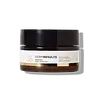What's inside
What's inside
 Key Ingredients
Key Ingredients

 Benefits
Benefits

 Concerns
Concerns

 Ingredients Side-by-side
Ingredients Side-by-side

Water
Skin ConditioningGlycerin
HumectantSqualane
EmollientCetearyl Alcohol
EmollientCrambe Abyssinica Seed Oil Phytosterol Esters
EmulsifyingCetyl Alcohol
EmollientHydrogenated Ethylhexyl Olivate
EmollientHydrogenated Polyisobutene
EmollientButyrospermum Parkii Butter
Skin ConditioningGlyceryl Stearate Se
EmulsifyingGlyceryl Oleate
EmollientImperata Cylindrica Root Extract
Skin ConditioningHydroxyethyl Acrylate/Sodium Acryloyldimethyl Taurate Copolymer
Emulsion StabilisingHydrogenated Olive Oil Unsaponifiables
EmollientOpuntia Ficus-Indica Stem Extract
Skin ConditioningCarbomer
Emulsion StabilisingAcrylates/C10-30 Alkyl Acrylate Crosspolymer
Emulsion StabilisingBisabolol
MaskingSodium Stearoyl Glutamate
CleansingSodium Phytate
Polyacrylate Crosspolymer-6
Emulsion StabilisingHydrolyzed Hyaluronic Acid
HumectantPhenoxyethanol
PreservativeCaprylyl Glycol
EmollientSorbitan Isostearate
EmulsifyingPolysorbate 60
EmulsifyingAlcohol
AntimicrobialSodium Hydroxide
BufferingFarnesol
PerfumingWater, Glycerin, Squalane, Cetearyl Alcohol, Crambe Abyssinica Seed Oil Phytosterol Esters, Cetyl Alcohol, Hydrogenated Ethylhexyl Olivate, Hydrogenated Polyisobutene, Butyrospermum Parkii Butter, Glyceryl Stearate Se, Glyceryl Oleate, Imperata Cylindrica Root Extract, Hydroxyethyl Acrylate/Sodium Acryloyldimethyl Taurate Copolymer, Hydrogenated Olive Oil Unsaponifiables, Opuntia Ficus-Indica Stem Extract, Carbomer, Acrylates/C10-30 Alkyl Acrylate Crosspolymer, Bisabolol, Sodium Stearoyl Glutamate, Sodium Phytate, Polyacrylate Crosspolymer-6, Hydrolyzed Hyaluronic Acid, Phenoxyethanol, Caprylyl Glycol, Sorbitan Isostearate, Polysorbate 60, Alcohol, Sodium Hydroxide, Farnesol
Water
Skin ConditioningDicaprylyl Carbonate
EmollientDimethicone
EmollientNiacinamide
SmoothingZea Mays Starch
AbsorbentGlycerin
HumectantHydrogenated Coco-Glycerides
EmollientMethylpropanediol
SolventPentylene Glycol
Skin ConditioningC12-15 Alkyl Benzoate
AntimicrobialCaprylic/Capric Triglyceride
MaskingGlyceryl Stearate Citrate
EmollientTocopheryl Acetate
AntioxidantButyrospermum Parkii Butter
Skin ConditioningCetyl Alcohol
EmollientSodium Ascorbyl Phosphate
AntioxidantStearyl Alcohol
EmollientHydrolyzed Lupine Protein
Skin ConditioningDecarboxy Carnosine Hcl
Skin ConditioningDimethiconol
EmollientSteareth-21
CleansingSodium Polyacrylate
AbsorbentEthylhexylglycerin
Skin ConditioningAcrylates/C10-30 Alkyl Acrylate Crosspolymer
Emulsion StabilisingBenzyl Alcohol
PerfumingSodium Benzoate
MaskingSodium Hydroxide
BufferingTocopherol
AntioxidantWater, Dicaprylyl Carbonate, Dimethicone, Niacinamide, Zea Mays Starch, Glycerin, Hydrogenated Coco-Glycerides, Methylpropanediol, Pentylene Glycol, C12-15 Alkyl Benzoate, Caprylic/Capric Triglyceride, Glyceryl Stearate Citrate, Tocopheryl Acetate, Butyrospermum Parkii Butter, Cetyl Alcohol, Sodium Ascorbyl Phosphate, Stearyl Alcohol, Hydrolyzed Lupine Protein, Decarboxy Carnosine Hcl, Dimethiconol, Steareth-21, Sodium Polyacrylate, Ethylhexylglycerin, Acrylates/C10-30 Alkyl Acrylate Crosspolymer, Benzyl Alcohol, Sodium Benzoate, Sodium Hydroxide, Tocopherol
Ingredients Explained
These ingredients are found in both products.
Ingredients higher up in an ingredient list are typically present in a larger amount.
Acrylates/C10-30 Alkyl Acrylate Crosspolymer is a synthetic polymer. It is used to thicken and improve the texture of products. Due to its properties, it can prevent water and oil ingredients from separating.
This ingredient is also known as shea butter. It is an effective skin hydrator and emollient.
Emollients help soothe and soften your skin. It does this by creating a protective film on your skin. This barrier helps trap moisture and keeps your skin hydrated. Emollients may be effective at treating dry or itchy skin.
Shea butter is rich in antioxidants. Antioxidants help fight free-radicals, or molecules that may harm the body. It is also full of fatty acids including stearic acid and linoleic acid. These acids help replenish the skin and keep skin moisturized.
While Shea Butter has an SPF rating of about 3-4, it is not a sunscreen replacement.
Shea butter may not be fungal acne safe. We recommend speaking with a professional if you have any concerns.
Learn more about Butyrospermum Parkii ButterCetyl Alcohol is a fatty alcohol. Fatty Alcohols are most often used as an emollient or to thicken a product.
Its main roles are:
Though it has "alcohol" in the name, it is not related to denatured alcohol or ethyl alcohol.
The FDA allows products labeled "alcohol-free" to have fatty alcohols.
Learn more about Cetyl AlcoholGlycerin is already naturally found in your skin. It helps moisturize and protect your skin.
A study from 2016 found glycerin to be more effective as a humectant than AHAs and hyaluronic acid.
As a humectant, it helps the skin stay hydrated by pulling moisture to your skin. The low molecular weight of glycerin allows it to pull moisture into the deeper layers of your skin.
Hydrated skin improves your skin barrier; Your skin barrier helps protect against irritants and bacteria.
Glycerin has also been found to have antimicrobial and antiviral properties. Due to these properties, glycerin is often used in wound and burn treatments.
In cosmetics, glycerin is usually derived from plants such as soybean or palm. However, it can also be sourced from animals, such as tallow or animal fat.
This ingredient is organic, colorless, odorless, and non-toxic.
Glycerin is the name for this ingredient in American English. British English uses Glycerol/Glycerine.
Learn more about GlycerinSodium Hydroxide is also known as lye or caustic soda. It is used to adjust the pH of products; many ingredients require a specific pH to be effective.
In small amounts, sodium hydroxide is considered safe to use. However, large amounts may cause chemical burns due to its high alkaline.
Your skin has a natural pH and acid mantle. This acid mantle helps prevent harmful bacteria from breaking through. The acid mantle also helps keep your skin hydrated.
"Alkaline" refers to a high pH level. A low pH level would be considered acidic.
Learn more about Sodium HydroxideWater. It's the most common cosmetic ingredient of all. You'll usually see it at the top of ingredient lists, meaning that it makes up the largest part of the product.
So why is it so popular? Water most often acts as a solvent - this means that it helps dissolve other ingredients into the formulation.
You'll also recognize water as that liquid we all need to stay alive. If you see this, drink a glass of water. Stay hydrated!
Learn more about Water